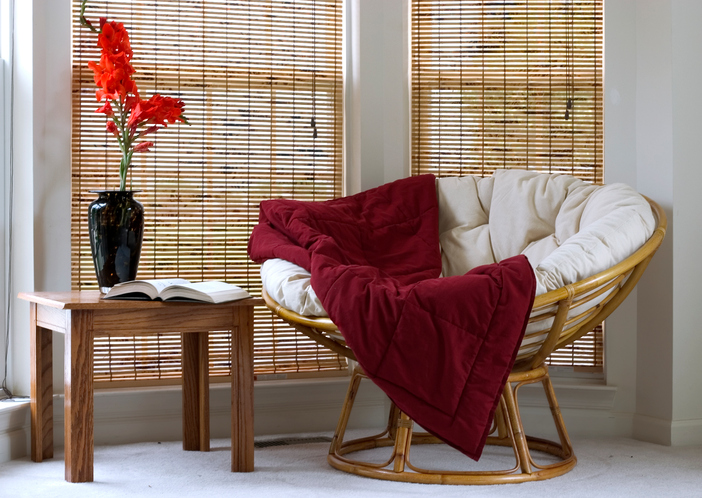 By Katie Laird
By Katie Laird
Homeowners are often scrambling for home improvement options that strike the right balance between affordability, functionality, aesthetics and eco-friendliness. Bamboo has been marketed as something of a panacea, a kind of wonder wood that checks all the boxes. And designers, contractors and consumers have all taken note, as bamboo has made its way into homes as flooring, walls, window treatments, furniture and more. Here are the properties that are making this popular material a go-to green choice for interior design materials.
Affordability
Bamboo is a readily available wood … except for the fact that bamboo isn’t a wood at all, but a grass! Therein lies the secret to bamboo’s ascendant success as a housing material: It grows like a weed because it essentially is one. At a maximum of three feet per day, it is, in fact, the fastest growing plant on Earth. This abundance means it’s an affordable and easily accessible choice in an increasing number of household design elements.
Versatility
Just the one word “bamboo” doesn’t do justice to the range of looks the material offers: It can vary greatly in shades and textures, making it a versatile option for decorators and designers. From the darkest darks to the palest natural shades, you can get just the right color to complement and accentuate the earth tones in your interior décor. For example, a homeowner with dark hardwood floors can choose dark bamboo shades to tie the room together. Just keep in mind that the color may change over time as the material ages, and tones may differ depending on where and when it was harvested (just as is the case with hardwood).
Indeed, bamboo window treatments are particularly popular, and they’re available in a variety of options ranging from Roman shades to woven blinds. Whatever style you go for, bamboo blinds can pull together a room’s earth tones into one elegantly cohesive package, while allowing natural sunlight to filter in. While bamboo on its own is not a black-out solution, you can add blackout liners to prevent any undesired light filtration.
Durability
Whether natural or manmade, few materials can match bamboo’s physical properties pound-for-pound. Because bamboo grows in wet, tropical climates, it is well-suited to resisting rain and wind. (East Asian cultures have made use of bamboo for centuries to build suspension bridges, huts, rafts and much more.) In fact, this unassuming reed beats out hardwood, brick and concrete alike in terms of compressive strength, while rivaling steel in tensile strength.
The result is a lightweight, flexible material that performs admirably in heavily-trafficked and humid areas of the home, making it a great option for floors and furniture in living areas, as well as window treatments in areas like the bathroom.
Interestingly, bamboo’s legendary durability persists even when it is broken down into its fibers. Rayon fabric, while luxuriously soft, is also incredibly strong. Add to that its natural anti-microbial properties, and you have a long-lasting material that is useful in a wide variety of textile applications.
Sustainability
As a growing number of homeowners look for eco-friendly materials in their décor, perhaps no single factor has contributed to bamboo’s modern vogue in interior design more than its sustainability. As it is a grass rather than a tree, it can grow to a harvestable size (often over 100 feet) in a matter of months. This is in stark contrast to the years of water, fertilizer and pesticide required by other timber woods. Additionally, bamboo can grow on steep slopes and depleted or abandoned agricultural lands that would otherwise go to waste.
The environmental benefits don’t stop there, either. Bamboo’s root systems are an effective reinforcement against soil erosion. Due to its fast-growing nature, bamboo farms that make responsible use of available land are an incredibly potent form of carbon sequestration. Finally, bamboo groves can produce up to 35% more oxygen than comparably sized forests.
Processing bamboo has made leaps and bounds in terms of eco-friendliness. While bamboo plywood has traditionally required formaldehyde in the production process, more and more researchers are finding breakthroughs that make durable and biodegradable glues an economic reality. However, it’s worth noting that most of the world’s bamboo timber is grown in China and India and therefore requires international shipping, and not all companies conform to the greenest methods of production.
When you consider bamboo’s low carbon footprint along with its durability and lasting appeal, it’s no wonder that it’s made its way to homes in the form of furniture, window treatments, flooring and more. When you elect to adorn your home with this wonder wood (er, grass) you can rest easier knowing that a more beautiful home can be kind to Mother Earth and your bank account alike.
Katie Laird is the director of Social Marketing for Blinds.com and a passionate home decorator for her family with a love of all things Mid-Century Modern and blue. To learn more about bamboo window treatments, visit the Blinds.com website.







